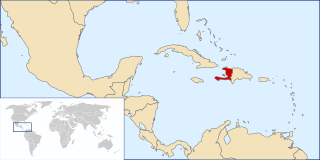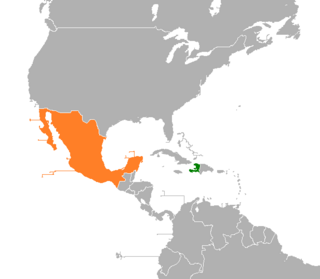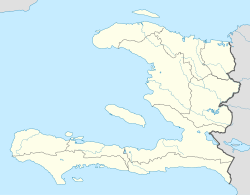
Haiti, officially the Republic of Haiti, and formerly known as Hayti, is a country on the island of Hispaniola in the Greater Antilles archipelago of the Caribbean Sea, east of Cuba and Jamaica, and south of The Bahamas and the Turks and Caicos Islands. It occupies the western three-eighths of the island which it shares with the Dominican Republic. To its south-west lies the small Navassa Island, which is claimed by Haiti but is disputed as a United States territory under federal administration. Haiti is 27,750 km2 (10,714 sq mi) in size, the third largest country in the Caribbean by area, and has an estimated population of 11.4 million, making it the most populous country in the Caribbean. The capital is Port-au-Prince.

Port-au-Prince is the capital and most populous city of Haiti. The city's population was estimated at 1,200,000 in 2022 with the metropolitan area estimated at a population of 2,618,894. The metropolitan area is defined by the IHSI as including the communes of Port-au-Prince, Delmas, Cite Soleil, Tabarre, Carrefour and Pétion-Ville.

Carrefour is a largely residential commune in the Port-au-Prince Arrondissement, in the Ouest department of Haiti. Port-au-Prince has a population of 1,234,742 while the commune has a population of 501,768.
Jean-Claude Bajeux was a Haitian political activist and professor of Caribbean literature. For many years he was director of the Ecumenical Center for Human Rights based in Haiti's capital, Port-au-Prince, and a leader of the National Congress of Democratic Movements, a moderate socialist political party also known as KONAKOM. He was Minister of Culture during Jean-Bertrand Aristide's first term as President of Haiti.

Cité Soleil is an extremely impoverished and densely populated commune located in the Port-au-Prince metropolitan area in Haiti. Cité Soleil originally developed as a shanty town and grew to an estimated 200,000 to 400,000 residents, the majority of whom live in extreme poverty. The area is generally regarded as one of the poorest and most dangerous areas of the Western Hemisphere and it is one of the biggest slums in the Northern Hemisphere. The area has virtually no sewers and has a poorly maintained open canal system that serves as its sewage system, few formal businesses but many local commercial activities and enterprises, sporadic but largely unpaid for electricity, a few hospitals, and two government schools, Lycee Nationale de Cité Soleil, and Ecole Nationale de Cité Soleil. For several years until 2007, the area was ruled by a number of gangs, each controlling their own sectors. But government control was reestablished after a series of operations in early 2007 by the United Nations Stabilization Mission in Haiti (MINUSTAH) with the participation of the local population.

Toussaint Louverture International Airport is an international airport in Tabarre, a commune of Port-au-Prince in Haiti. The airport is currently the busiest in Haiti and is an operating hub for Sunrise Airways.
Haiti faces key challenges in the water supply and sanitation sector: Notably, access to public services is very low, their quality is inadequate and public institutions remain very weak despite foreign aid and the government's declared intent to strengthen the sector's institutions. Foreign and Haitian NGOs play an important role in the sector, especially in rural and urban slum areas.

Michèle Bennett is the former First Lady of Haiti and the ex‑wife of former President of Haiti, Jean‑Claude Duvalier. They fled to France together when he resigned in 1986; they divorced in 1990.

Haiti–United States relations are bilateral relations between Haiti and the United States. Succeeding U.S. presidents refused to recognize Haiti until Abraham Lincoln. The U.S. tried to establish a military base in Haiti and invaded. It withdrew in 1934 but continued to intervene in Haiti during subsequent decades.

The following is an alphabetical list of topics related to Haiti.
Tourism in Haiti is an industry that has generated just under a million arrivals in 2012, and is typically one of the main sources of revenue for the nation. With its favorable climate, second longest coastline of beaches and most mountainous ranges in the Caribbean, waterfalls, caves, colonial architecture and distinct cultural history, Haiti has had its history as an attractive destination for tourists. However, unstable governments have long contested its history and the country's economic development throughout the 20th century.

The 2010 Haiti earthquake was a catastrophic magnitude 7.0 Mw earthquake that struck Haiti at 16:53 local time on Tuesday, 12 January 2010. The epicenter was near the town of Léogâne, Ouest department, approximately 25 kilometres (16 mi) west of Port-au-Prince, Haiti's capital.
Crime in Haiti is investigated by the Haitian police.
Leslie Delatour (1950–2001) was a Haitian economist who served as governor of the Bank of the Republic of Haiti from 1994 to 1998, and as Haiti's Minister of Finance from 1986 to 1988.
Haitian Carnival is a celebration held over several weeks each year leading up to Mardi Gras. Haitian Defile Kanaval is the Haitian Creole name of the main annual Mardi Gras carnival held in Port-au-Prince, Haiti.
American Haitians comprise the descendants of free blacks from the United States to Haiti in the early 19th century as well as recent immigrants and expatriates as well as their locally born descendants. At the time of the 2010 Haiti earthquake, there were about 45,000 US citizens living in Haiti.

Haiti–Mexico relations are the diplomatic relations between Haiti and Mexico. Both nations are members of Association of Caribbean States, Community of Latin American and Caribbean States, Organization of American States and the United Nations.

The Duvalier dynasty was an autocratic hereditary dictatorship in Haiti that lasted almost 29 years, from 1957 until 1986, spanning the rule of the father-and-son duo François and Jean-Claude Duvalier.

Cuba-Haiti relations refer to the bilateral relations between Cuba and Haiti. Cuba has an embassy in Port-au-Prince and Haiti has an embassy in Havana.
Raymond Cassagnol was a Haitian Air Force officer/flight instructor, alleged Haitian rebel leader, and one of the first Haitian Tuskegee Airmen, "Red Tails," or “Schwartze Vogelmenschen” or among enemy German pilots. Cassagnol was an aviation classmate and roommate of Daniel James Jr., the first-ever African American four-star general.













